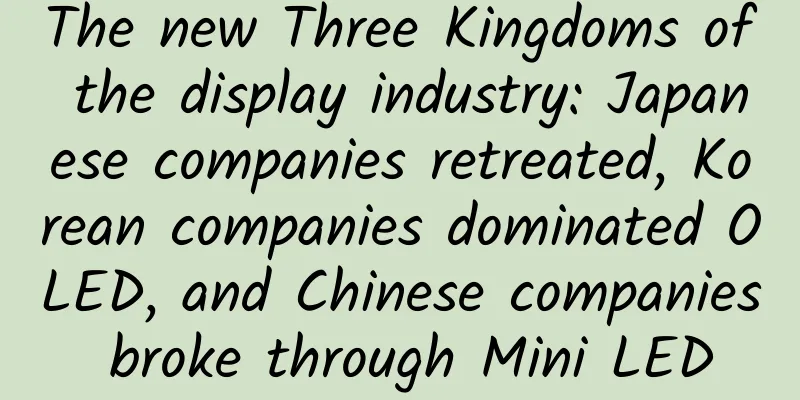The new Three Kingdoms of the display industry: Japanese companies retreated, Korean companies dominated OLED, and Chinese companies broke through Mini LED

|
In today's international competition, high technology is undoubtedly the most important core force. It can be seen from the fact that Chinese companies have been frequently "choked" in the past two years that only by mastering core technologies can we truly master the industry's discourse power. When it comes to high technology, most people may first think of mobile phones and computers, especially the chips inside them. However, the display screen, which is the "window" for people to contact chips, is often easily overlooked in terms of its technological content, and its position in the industrial chain is also more easily underestimated. Take mobile phones for example. In July this year, the sales of the iPhone 12 series have exceeded 100 million units, and its entire series of screens are from Samsung and LG in South Korea. In the field of television, LG and Samsung still play an important role. LG basically takes charge of all the OLED TV panel production in the world. At present, the market share of OLED TV has exceeded 10%, and the shipment volume in the first half of this year has reached 2.47 million units. In the field of high-end electronic products, a considerable part of the global income flows into the pockets of these two Korean manufacturers, making the display industry account for more than 3.4% of South Korea's GDP. In November last year, when South Korea's exports had been negative for six consecutive months due to the impact of the epidemic, it was the strong growth in exports of industries such as display equipment that led to a rebound in South Korea's total exports, a year-on-year increase of 4%. More importantly, LG and Samsung have also gained significant voice in the fields of mobile phones, televisions, etc. by supplying screens. Just over 10 years ago, this position was occupied by Japanese manufacturers. Contrary to expectations, the decline of Japan's display industryJapan occupies a pivotal position in the global technology industry chain. Brands such as Sony, Panasonic, and Toshiba have penetrated into every gap in all walks of life. However, in the display industry, except for Sony, Toshiba and Panasonic have basically surrendered, leaving only Sharp and JDI struggling to hold on. In the late 1990s, Japan's display industry was still thriving, and they even began to think about the successor of LCD before LCD completely dominated the market. Sony, with its outstanding technical strength, had already set its sights on OLED at that time, and companies such as Sharp and Panasonic had their own plans for the future. In addition, even the camera giant Canon got involved and established a joint venture with Toshiba in 2004 to jointly develop SED TVs, which were scheduled to be released three years later in 2007. Also in 2007, Sony released the world's first OLED TV, and the future looked bright. But the collapse also began from here. During the years when Canon and Toshiba were working hard to develop SED, the price of LCD panels began to drop rapidly, which made LCD TV manufacturers dare to engage in price wars. However, SED TVs, which had not yet entered the mass production stage, could not reduce costs. In addition, Canon was involved in a patent dispute related to SED, which made Toshiba back down and sold its shares in the joint venture in early 2007. There is no need to say much about the subsequent story. Just look at how many people still know about SED and you will understand. Although Sony was the first to start in the field of OLED, the technology was still too advanced to be mass-produced in 2007. The world's first OLED TV, Sony XEL-1, had a screen of only 11 inches and only sold 2,000 units, with mixed reviews from consumers who bought it. In the end, Sony did not wait for the dawn after the darkness and withdrew from the OLED TV market in 2010. As for Sharp and JDI, which held on to LCD, they were at a loss what to do under the rapid impact of OLED. Not only were they slow to realize it, but the technology was also extremely slow to be implemented. It was only after five years of research on OLED technology that they had their first product line. Just as Japan's display industry was dying down, South Korea, also from East Asia, was rising strongly. Investing against the trend: the rapid development of South Korea's display industryThe opportunity for the rise of the Korean display industry came during the Asian financial crisis. In this crisis, the Korean economy was hit hard and it was determined to reshape its economic model and shift its focus to technology research and development. Korean companies have found that when an industry turns from prosperity to decline, the original leading manufacturers will reduce the scale of production and R&D, and if new entrants choose to increase investment at this time, they are more likely to catch up when the market prospers again. This method is called "counter-cyclical investment", and Korea's semiconductor industry has risen from this, and they have also adopted the same method in the display industry. Samsung and LG, the two major Korean oligarchs, have simultaneously set their sights on LCD panels. At that time, the global panel industry market was shrinking, especially in Japan, which was also hit by the financial crisis, and major manufacturers were reducing their investments. However, Korean companies seized this opportunity, invested counter-cyclically, built large-scale production lines, and even built factories directly in Japan and recruited local engineers, thus acquiring world-leading technology in one fell swoop. The two companies' counter-trend move soon paid off. By 1999, Samsung and LG's global LCD panel market shares reached 18.8% and 16.2% respectively, ranking top two in the world. The decline of Japan's display industry was largely due to the fact that it had technology but could not turn it into products. Samsung and LG did not make such a mistake. They quickly started producing their own TVs and monitors and thus gained a foothold in the display industry. If the Asian financial crisis was the catalyst for the rise of South Korea's LCD industry, then the Fannie and Freddie financial crisis in the United States a decade later became the catalyst for South Korea's OLED takeoff. Although Japan started working on OLED earlier, they underestimated the industry risks brought by the immature technology. Sony's XEL-1 failed and the financial crisis hit. Due to the slow returns from large investments in the display industry, many Japanese companies reduced their investment in this field, which once again gave Samsung and LG a chance to rise. In the face of the financial crisis, Samsung and LG invested heavily in the research and development of OLED technology. Samsung was once ridiculed by the Japanese as "mass production of OLED screens is equivalent to climbing Mount Fuji upside down." However, Samsung still resolutely promoted the research and development of OLED and finally achieved mass production. In 2017, Apple's iPhone X adopted Samsung's OLED screen, marking the official maturity of Samsung's display technology. Previously, Apple's LCD screen supplier was Japan's JDI. Today, Samsung's share of the mobile phone OLED screen market has exceeded 90%, but JDI has long been suffering. Unlike Samsung, which focuses on small-screen mobile phones, LG is the leader in the large-screen OLED market and is the world's largest supplier of OLED TV panels. Even Sony, a long-established TV manufacturer, needs to purchase goods from LG. From the ups and downs of Japanese and Korean companies in the display field, we can see that Japanese companies have both technology and vision, but their technology is implemented too slowly and their investment in new technologies is not resolute enough, while Korean companies have officially overcome these weaknesses and have come from behind to surpass them. In the past two years, emerging display technologies represented by Mini LED have also begun to rise rapidly. This time, Chinese companies have become the protagonists who seized the opportunity. TCL wins the Mini LED battle to help China's smart manufacturingFrom CRT to LCD, and then to OLED, every change in display technology will trigger a new round of industrial transformation and reshape the competition landscape on a global scale. Unfortunately, Chinese companies have only played the role of pursuers and followers in the display industry. In recent years, as my country has increased its investment in science and technology, the industry's technological level has continued to improve, and the gap with foreign countries has gradually narrowed. The number of patents in important artificial intelligence fields such as voice and image has reached the world's leading level. In the field of display technology, the commissioning of the 11th generation LCD production line also marks that Chinese companies will change their roles, from followers to challenge industry leaders. In this wave of emerging display technologies, Mini LED is undoubtedly one of the most outstanding representatives. As an upgraded and evolved technology based on LCD, Mini LED has the characteristics of zone dimming, high color rendering, high contrast, etc., and it will not have the phenomenon of "screen burn-in" common in OLED products. At the same time, Mini LED is still a technology in its infancy worldwide, and foreign companies have not yet formed a huge technological monopoly advantage. For domestic companies, Mini LED has undoubtedly become an excellent breakthrough to seize development opportunities. When it comes to Mini LED, the world looks to China, and China looks to TCL. As early as 2017, TCL began the research and development of Mini LED technology, and released the world's first Mini LED backlit TV a year later. In 2019, TCL took the lead in mass production of Mini LED TVs. In 2020, TCL's sales in the global Mini LED product market accounted for 90%. At present, TCL has completed the global mass production of the third-generation Mini LED technology products. In addition, TCL also pioneered the OD Zero technology (Optical Distance 0), which means compressing the distance between the top of the backlight and the lower surface of the diffuser plate in the Mini LED backlight module to 0, making the appearance of the fuselage thinner and lighter. In addition, OD Zero Mini LED can also achieve a peak brightness of 3000 nits, bringing a wider dynamic range, higher contrast and richer color levels. Compared with OLED, OD Zero Mini LED has lower cost and longer backlight life, and its market potential is unquestionable. At present, TCL already has Mini LED smart screen products such as 75 X10, TCL 6 series, TCL R63, C12, X12, etc., covering a multi-price product line from high-end flagship to affordable level, turning technology into reality, greatly filling the gap in the industry and seizing the market opportunity. TCL has made early arrangements, made heavy investments, grasped technology and achieved output in the Mini LED field, which is exactly the same as the exploration of Korean companies in the OLED field back then. At the same time, the global economy is in an uncertain state. Samsung and LG withdrew from the LCD market last year. TCL's increased investment in Mini LED at this time is also a "counter-cyclical investment". It can be said that TCL is already a leader in the Mini LED industry, and we have reason to believe that it can also become a pioneer of a new era. While developing products, TCL is also actively cooperating with all parties to jointly promote the progress of the domestic Mini LED industry. In 2020, TCL Huaxing, as the second drafting unit, participated in the preparation process of the "General Technical Specifications for Mini-LED Commercial Displays", which is also the first domestic Mini LED commercial display group standard. On July 30 this year, the second Global Mini/Micro LED Display Industry Leaders Summit was held in Shanghai, China. TCL served as the co-organizer of the Mini LED Backlight Conference and participated as the leader of the "Mini LED Backlight LCD TV Technical Specifications" and "Mini LED Backlight LCD TV Test Methods" standards release ceremony, further leading the development of the industry. The "Smart Manufacturing in China" plan of "Smart Manufacturing in China 2025" points out: "Only by starting with core competitiveness such as technology to accelerate supply-side structural reform, integrating industrial chain resources, and opening up production, distribution, circulation, consumption and other links, can the domestic manufacturing industry promote the evolution of 'Made in China' to 'Smart Manufacturing in China', and then seek a new competitive landscape in the global field." Mini LED, which has a complex manufacturing process, has become a typical representative of China's high-end manufacturing industry, and domestic leading panel companies represented by TCL Huaxing are vigorously building related panel production lines. I believe that under the leadership of TCL, my country's Mini LED products will surely go global and become a new business card full of technological content for "China's Intelligent Manufacturing". As a winner of Toutiao's Qingyun Plan and Baijiahao's Bai+ Plan, the 2019 Baidu Digital Author of the Year, the Baijiahao's Most Popular Author in the Technology Field, the 2019 Sogou Technology and Culture Author, and the 2021 Baijiahao Quarterly Influential Creator, he has won many awards, including the 2013 Sohu Best Industry Media Person, the 2015 China New Media Entrepreneurship Competition Beijing Third Place, the 2015 Guangmang Experience Award, the 2015 China New Media Entrepreneurship Competition Finals Third Place, and the 2018 Baidu Dynamic Annual Powerful Celebrity. |
<<: Top Thai media group visits GAC Aion and praises it as the "most valuable" Chinese brand
>>: Suarez's "crazy gene" for biting: a primitive impulse
Recommend
Four low-Earth orbits are running simultaneously! my country's "precipitation star" has become a regular star!
On May 1, Fengyun-3G, which we often call the &qu...
In memory of him! He gave up his high salary to build the "Dongfeng" for the country and made immortal contributions to China's aerospace industry
Seven years ago today, an old man named Liang Sil...
Microsoft Office iOS version is now available on the App Store
Microsoft had previously announced that it would ...
"Space rocks" found in the desert, subverting human understanding of the solar system?
Space rock could rewrite early solar system histo...
Do you know how important this inconspicuous little moss is?
Disclaimer: In accordance with general ecological...
Scientists reveal: What did the ancient human "Mengzi people" look like 14,000 years ago?
Xinhua News Agency, Kunming, July 15 (Reporter Yu...
A 16-year-old girl was diagnosed with advanced gastric cancer due to frequent stomach bloating! Gastric cancer at a young age may be caused by "feeding"
April 10, Zhengzhou, Henan. A 16-year-old girl of...
Pagodas suppress sea monsters! The killer of the Ordovician ocean: Sinian hornstone
The New Bride Stone in Nanyan, the thunderbolt pr...
Experience the first version of Android 9.0: Like these 6 changes
A few days ago, Google quietly released the lates...
98sjw Catering Franchise Website Analysis Report
1. Keyword analysis The keywords of 98sjw caterin...
After the rules of the game for new energy vehicles have changed, Korean batteries are having a hard time gaining a foothold
On March 30, the new energy vehicle battery facto...
5,000 words of in-depth information to reveal the secrets of offline event promotion!
When it comes to organizing events, it is a love-...
A nucleic acid sampling worker in Beijing was diagnosed! Experts urgently remind that masks should be worn like this →
According to the Beijing Municipal Health Commiss...
【Full course】Dou Shenda Chinese Classical Poetry Lecture Baidu Cloud Disk
【Full course】Dou Shenda Chinese Classical Poetry ...
Channels are no longer king: Tencent Games will be forced to open its arms
At the just concluded Tencent 2014TGC, the author...









